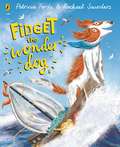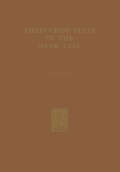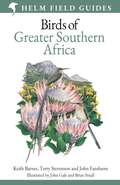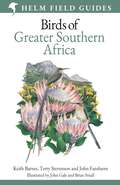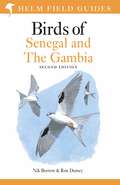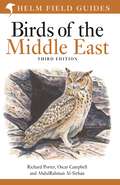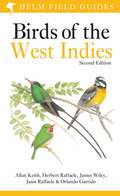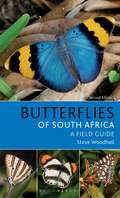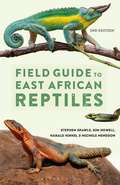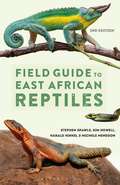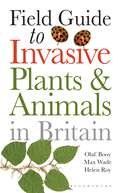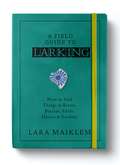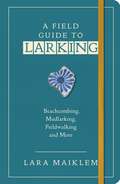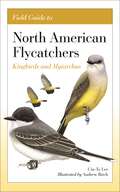- Table View
- List View
Fidget the Wonder Dog
by Patricia FordeA tale-of-truest friendship bookA fill-my-heart with love bookA read-again-and-again bookAn epic tale of love, loss, reunion and adventure on the high seas told through the friendship of a girl and her dog, Fidget.Written by debut picture-book author Trish Forde and illustrated by rising star Rachael Saunders, this is a book that combines humour and heart with a faultless read-aloud rhythm
Field Guide to Alpine Wildlife (Bloomsbury Naturalist)
by Thomas GretlerAn essential companion for anyone visiting or hiking in the Alpine regions of France, Germany, Italy, Austria, Slovenia, Switzerland and Liechtenstein. The Alps remain one of Europe's foremost tourist destinations – not just for its world-famous scenery, but also its remarkable and diverse wildlife. This wild diversity is covered in this new field guide to the region. Field Guide to Alpine Wildlife covers all of the animals and plants you are likely to see on a trip to this extraordinary place including mammals such as Mouflon and Ibex, birds like Bearded Vulture, White-winged Snowfinch and Wallcreeper, and a diversity of insects and wild flowers that will stop even seasoned wildlife-watchers in their tracks. It is packed with photography of each species, with photos carefully chosen to help pinpoint key identification criteria. Portable and pocket-friendly – crucial for all travellers in this mountainous region – this book is an essential companion for anyone visiting or walking through this spectacular part of central Europe.
Field Guide to Alpine Wildlife (Bloomsbury Naturalist)
by Thomas GretlerAn essential companion for anyone visiting or hiking in the Alpine regions of France, Germany, Italy, Austria, Slovenia, Switzerland and Liechtenstein. The Alps remain one of Europe's foremost tourist destinations – not just for its world-famous scenery, but also its remarkable and diverse wildlife. This wild diversity is covered in this new field guide to the region. Field Guide to Alpine Wildlife covers all of the animals and plants you are likely to see on a trip to this extraordinary place including mammals such as Mouflon and Ibex, birds like Bearded Vulture, White-winged Snowfinch and Wallcreeper, and a diversity of insects and wild flowers that will stop even seasoned wildlife-watchers in their tracks. It is packed with photography of each species, with photos carefully chosen to help pinpoint key identification criteria. Portable and pocket-friendly – crucial for all travellers in this mountainous region – this book is an essential companion for anyone visiting or walking through this spectacular part of central Europe.
Field Guide to Birds of Greater Southern Africa (Helm Field Guides)
by Mr Keith Barnes Terry Stevenson John FanshaweThis spectacular field guide includes all resident, breeding and migrant species found in Greater Southern Africa.Comprising South Africa, Lesotho, eSwatini, Namibia, Botswana, Zimbabwe, Malawi, Mozambique and Zambia, Greater Southern Africa is a vast region home to a truly extraordinary diversity of avifauna.The latest in the Helm Field Guide series, Birds of Greater Southern Africa describes all 1,170 regularly occurring species that are likely to be encountered in the region, from the Wandering Albatross to the Pennant-winged Nightjar. Featuring 272 colour plates by three of the world's leading bird illustrators, this practical guide also includes concise species accounts describing key identification features, status, range, habitat and voice; distribution maps for each species are also included.Fully illustrated throughout, this is an essential reference guide for anyone visiting or living in this wildlife-rich area.
Field Guide to Birds of Greater Southern Africa (Helm Field Guides)
by Mr Keith Barnes Terry Stevenson John FanshaweThis spectacular field guide includes all resident, breeding and migrant species found in Greater Southern Africa.Comprising South Africa, Lesotho, eSwatini, Namibia, Botswana, Zimbabwe, Malawi, Mozambique and Zambia, Greater Southern Africa is a vast region home to a truly extraordinary diversity of avifauna.The latest in the Helm Field Guide series, Birds of Greater Southern Africa describes all 1,170 regularly occurring species that are likely to be encountered in the region, from the Wandering Albatross to the Pennant-winged Nightjar. Featuring 272 colour plates by three of the world's leading bird illustrators, this practical guide also includes concise species accounts describing key identification features, status, range, habitat and voice; distribution maps for each species are also included.Fully illustrated throughout, this is an essential reference guide for anyone visiting or living in this wildlife-rich area.
Field Guide to Birds of Senegal and The Gambia: Second Edition (Helm Field Guides)
by Nik Borrow Ron DemeyThis comprehensive and fully updated edition of Birds of Senegal and The Gambia is the ultimate guide for travellers and birdwatchers visiting one of Africa's richest birdwatching regions. The Gambia, together with the country that envelops it, Senegal, has an avifauna of more than 700 regularly occurring species, including many Western Palearctic migrants from September to April, and a significant list of highly sought-after resident West African birds, including the Egyptian Plover. This authoritative guide covers all species, including details of all residents, migrants and known vagrants. Senegal and The Gambia offer a true wealth of birdlife, including a fantastic selection of Sahel specialities that are far more easily seen here than anywhere else. Senegal has become a reliable locality for Golden Nightjar, Quail-plover and Cricket Warbler, and the near-endemic Mali Firefinch occurs in the southeast of the country. Birdwatchers in this region can also find Savile's Bustard, Adamawa Turtle Dove, Little Grey Woodpecker, Yellow Penduline Tit, Sudan Golden Sparrow and Exclamatory Paradise Whydah, while the Saloum delta's huge roost of tens of thousands of African Swallow-tailed Kites is one of the world's top birding spectacles. More than 140 stunning colour plates depict every species and also comprehensively cover all the distinct plumages and subspecies likely to be encountered. Concise species accounts describe key identification features, status, range, habitat and voice, with fully updated distribution maps for each species. This compact guide is an essential companion for any birder visiting this rich and varied area of Western Africa.
Field Guide to Birds of Senegal and The Gambia: Second Edition (Helm Field Guides)
by Nik Borrow Ron DemeyThis comprehensive and fully updated edition of Birds of Senegal and The Gambia is the ultimate guide for travellers and birdwatchers visiting one of Africa's richest birdwatching regions. The Gambia, together with the country that envelops it, Senegal, has an avifauna of more than 700 regularly occurring species, including many Western Palearctic migrants from September to April, and a significant list of highly sought-after resident West African birds, including the Egyptian Plover. This authoritative guide covers all species, including details of all residents, migrants and known vagrants. Senegal and The Gambia offer a true wealth of birdlife, including a fantastic selection of Sahel specialities that are far more easily seen here than anywhere else. Senegal has become a reliable locality for Golden Nightjar, Quail-plover and Cricket Warbler, and the near-endemic Mali Firefinch occurs in the southeast of the country. Birdwatchers in this region can also find Savile's Bustard, Adamawa Turtle Dove, Little Grey Woodpecker, Yellow Penduline Tit, Sudan Golden Sparrow and Exclamatory Paradise Whydah, while the Saloum delta's huge roost of tens of thousands of African Swallow-tailed Kites is one of the world's top birding spectacles. More than 140 stunning colour plates depict every species and also comprehensively cover all the distinct plumages and subspecies likely to be encountered. Concise species accounts describe key identification features, status, range, habitat and voice, with fully updated distribution maps for each species. This compact guide is an essential companion for any birder visiting this rich and varied area of Western Africa.
Field Guide To The Birds Of South-East Asia (Field Guide To)
by Craig RobsonThis is the first-time flexi-cover edition of this classic field guide, which is the definitive volume on the region's birdlife. This award-winning book, which was first published in 2000, was fully updated in 2009 to include 76 new species for the region that were recent new discoveries for science, taxonomic 'splits' or had been recorded there for the first time. This comprehensive field guide to the birds of South-East Asia covers all of the 1,327 species recorded in the region and each has been fully illustrated. This edition has many new artworks and 16 more colour plates than the original guide, and the text has been meticulously updated to take in all the most recent information. The vast diversity of South-East Asian birdlife attracts increasing numbers of birdwatchers each year. Covering Thailand, Vietnam, Singapore, Peninsular Malaysia, Myanmar, Laos and Cambodia, this unique and indispensable guide covers in detail the identification, voice, breeding, status, habitat and distribution of all the species and distinctive subspecies of the region.
Field Guide to Birds of the Middle East: Third Edition (Helm Field Guides)
by Richard Porter Oscar Campbell Mr AbdulRahman Al-SirhanThe ultimate field guide to the birds of the Middle East, an indispensable companion for any traveller to the region The Middle East – the region stretching from Cyprus and the Levant to Iran, including Turkey and the Arabian Peninsula, plus Socotra – has a wonderfully broad and diverse avifauna, featuring a host of wintering and passage migrants, enigmatic breeders, and even a few endemics that occur nowhere else. This authoritative book covers more than 895 species recorded in the Middle East, including details of all regular visitors and breeding species, from the Purple Sunbird to the Northern Bald Ibis. Featuring 180 stunning colour plates by three of the world's leading bird illustrators, this practical guide also includes concise species accounts describing key identification features, status, range, habitat and voice with fully updated distribution maps for each species. Written by three of the leading lights in regional ornithology and conservation, this fully revised and expanded guide is an essential reference for any birder living in or visiting the Middle East.
Field Guide to Birds of the Middle East: Third Edition (Helm Field Guides)
by Richard Porter Oscar Campbell Mr AbdulRahman Al-SirhanThe ultimate field guide to the birds of the Middle East, an indispensable companion for any traveller to the region The Middle East – the region stretching from Cyprus and the Levant to Iran, including Turkey and the Arabian Peninsula, plus Socotra – has a wonderfully broad and diverse avifauna, featuring a host of wintering and passage migrants, enigmatic breeders, and even a few endemics that occur nowhere else. This authoritative book covers more than 895 species recorded in the Middle East, including details of all regular visitors and breeding species, from the Purple Sunbird to the Northern Bald Ibis. Featuring 180 stunning colour plates by three of the world's leading bird illustrators, this practical guide also includes concise species accounts describing key identification features, status, range, habitat and voice with fully updated distribution maps for each species. Written by three of the leading lights in regional ornithology and conservation, this fully revised and expanded guide is an essential reference for any birder living in or visiting the Middle East.
Field Guide to Birds of the West Indies: Second Edition
by Allan Keith Herbert Raffaele Janis Raffaele James Wiley Orlando GarridoBirds of the West Indies is the first field guide that covers and depicts all birds known to occur in the region, including infrequently occurring and introduced forms. Now fully updated and expanded, this stunningly illustrated book features detailed accounts of more than 600 species, describing field marks, range, status, voice and habitat. More than 100 beautiful colour plates depict plumages of all species, and the book includes distribution maps, a colour code for endemics, and an incisive introduction that discusses avifaunal changes in the West Indies over the past fifteen years.
Field Guide to Birds of the West Indies: Second Edition
by Allan Keith Herbert Raffaele Janis Raffaele James Wiley Orlando GarridoBirds of the West Indies is the first field guide that covers and depicts all birds known to occur in the region, including infrequently occurring and introduced forms. Now fully updated and expanded, this stunningly illustrated book features detailed accounts of more than 600 species, describing field marks, range, status, voice and habitat. More than 100 beautiful colour plates depict plumages of all species, and the book includes distribution maps, a colour code for endemics, and an incisive introduction that discusses avifaunal changes in the West Indies over the past fifteen years.
Field Guide to Birds of Western Africa: 2nd Edition (Helm Field Guides)
by Nik BorrowBirds of Western Africa (Helm, 2001) was the first single-volume guide to cover all the species of this region, which comprises 23 countries from Senegal and southern Mauritania east to Chad and the Central African Republic, and south to Congo. This new edition uses all of the plates from Birds of Western Africa, with a concise, authoritative text on facing pages, to create a conveniently-sized, lightweight field reference covering all 1300 species found in the region. The book also has updated colour distribution maps for each species placed on the text pages for the first time. A number of new images have been painted for this new edition and several of the illustrations have been replaced. This major new guide will enable birders to identify any species found in any of the countries covered.
Field Guide to Butterflies of South Africa: Second Edition
by Steve WoodhallThis spectacular new edition of Field Guide to Butterflies of South Africa is the only guide to cover all 671 butterfly species that occur in South Africa. Fully revised and expanded, it includes notes on size, identification, habitat, flight periods and larval food sources, plus notes on mimicry, plus accurate maps. More than 2,000 photographs fully showcase the region's diverse butterfly fauna, with full-colour images of male and female forms (where different) and of upper- and undersides (where possible) on pages facing the species entries, for easy reference. Designed for easy identification and optimal use in the field, this guide is an invaluable resource for any visiting naturalist or tourist to the country.
Field Guide to Butterflies of South Africa: Second Edition
by Steve WoodhallThis spectacular new edition of Field Guide to Butterflies of South Africa is the only guide to cover all 671 butterfly species that occur in South Africa. Fully revised and expanded, it includes notes on size, identification, habitat, flight periods and larval food sources, plus notes on mimicry, plus accurate maps. More than 2,000 photographs fully showcase the region's diverse butterfly fauna, with full-colour images of male and female forms (where different) and of upper- and undersides (where possible) on pages facing the species entries, for easy reference. Designed for easy identification and optimal use in the field, this guide is an invaluable resource for any visiting naturalist or tourist to the country.
Field Guide to East African Reptiles
by Steve Spawls Kim Howell Harald Hinkel Michele MenegonEast Africa is home to a remarkable assemblage of reptiles, from crocodiles and chameleons to turtles and tortoises, lizards, worm-lizards, and a stunning array of snakes. The region is a true herpetological hot-spot.This fully revised edition of the classic field guide to the region's reptiles explores the full diversity of these animals. With updated text, detailed maps and more than 600 new photographs, this book includes every one of the 500 or so species in the region. All are described and mapped, with virtually every species accompanied by at least one colour photograph. Comprehensive and definitive, Field Guide to East African Reptiles is an essential tool for all naturalists, conservationists, educators, field workers, medical personnel and students in the region.
Field Guide to East African Reptiles
by Steve Spawls Kim Howell Harald Hinkel Michele MenegonEast Africa is home to a remarkable assemblage of reptiles, from crocodiles and chameleons to turtles and tortoises, lizards, worm-lizards, and a stunning array of snakes. The region is a true herpetological hot-spot.This fully revised edition of the classic field guide to the region's reptiles explores the full diversity of these animals. With updated text, detailed maps and more than 600 new photographs, this book includes every one of the 500 or so species in the region. All are described and mapped, with virtually every species accompanied by at least one colour photograph. Comprehensive and definitive, Field Guide to East African Reptiles is an essential tool for all naturalists, conservationists, educators, field workers, medical personnel and students in the region.
The Field Guide to Fleece: 100 Sheep Breeds & How to Use Their Fibers
by Carol Ekarius Deborah RobsonAn indispensable, easy-to-read guide for knitters, spinners, and weavers eager to learn about the qualities of fleece and make the most of their projects.
Field Guide to Invasive Plants and Animals in Britain
by Olaf Booy Max Wade Helen RoyThe impact of invasive organisms is second only to habitat loss as a threat to biodiversity and yet, despite increasing ecological awareness, people remain largely unaware of these plants and animals and their potentially devastating impact. Although most biological introductions fail, many prove successful and these can prove disastrous for native fauna and flora.This field guide will enable the identification of a range of invasive plants and animals now found in Britain. Though these species are of particular concern to conservationists there has previously been no unified guide devoted to their recognition. This book will act both as an ID guide, appealing to the amateur naturalist, and as an important tool for ecologists and land managers attempting to tackle the problem posed by invasive species.
Field Guide to Invasive Plants and Animals in Britain
by Olaf Booy Max Wade Helen RoyThe impact of invasive organisms is second only to habitat loss as a threat to biodiversity and yet, despite increasing ecological awareness, people remain largely unaware of these plants and animals and their potentially devastating impact. Although most biological introductions fail, many prove successful and these can prove disastrous for native fauna and flora.This field guide will enable the identification of a range of invasive plants and animals now found in Britain. Though these species are of particular concern to conservationists there has previously been no unified guide devoted to their recognition. This book will act both as an ID guide, appealing to the amateur naturalist, and as an important tool for ecologists and land managers attempting to tackle the problem posed by invasive species.
A Field Guide to Larking
by Lara MaiklemA Field Guide to Larking is a practical, interactive and inspiring guide to 'larking' from the bestselling author of Mudlarking. To lark is to get out and about, to explore the world around us and to discover the little treasures hiding in plain sight. We think, of course, of mudlarking but there is also beachlarking, fieldlarking or even simply exploring your own home with fresh eyes. In this beautiful field guide, Lara teaches us how to lark for ourselves. There are maps and charts, tips and lists, and colour illustrations throughout to help identify finds. From tide tables for mudlarkers to a flint guide for fieldlarkers, this book is richly informative and yet small enough to pop in a pocket. Like a journal it invites you to interact – to make notes and record finds along the way.If Lara Maiklem's first book was a glimpse into a hidden world, with this field guide she shows us how we can discover it for ourselves.
A Field Guide to Larking
by Lara MaiklemA Field Guide to Larking is a practical, interactive and inspiring guide to 'larking' from the bestselling author of Mudlarking. To lark is to get out and about, to explore the world around us and to discover the little treasures hiding in plain sight. We think, of course, of mudlarking but there is also beachlarking, fieldlarking or even simply exploring your own home with fresh eyes. In this beautiful field guide, Lara teaches us how to lark for ourselves. There are maps and charts, tips and lists, and colour illustrations throughout to help identify finds. From tide tables for mudlarkers to a flint guide for fieldlarkers, this book is richly informative and yet small enough to pop in a pocket. Like a journal it invites you to interact – to make notes and record finds along the way.If Lara Maiklem's first book was a glimpse into a hidden world, with this field guide she shows us how we can discover it for ourselves.
Field Guide to North American Flycatchers: Kingbirds and Myiarchus
by Cin-Ty LeeA richly illustrated, portable guide to two of the most challenging groups of flycatchers to identify in the fieldThe identification of flycatchers can be a daunting challenge for even the most seasoned birder. The Field Guide to North American Flycatchers series takes bird identification to an entirely new level by training readers to observe subtle differences in structure, color patterns, and vocalizations before delving into the finer details of a particular species.Because the plumages of flycatchers are so similar, this innovative guide uses illustrations that highlight slight variations among species that photos often miss. One of the last frontiers of bird identification is now accessible to everyone—once one knows what to look for.Uses a holistic approach that makes flycatcher identification possible even for beginnersFeatures a wealth of beautiful illustrations that depict every species in North AmericaShows how to observe subtle differences in structure, plumage contrasts, and vocalizations, which together create a distinctive overall impression of the birdIncludes detailed audio spectrograms and seasonal distribution maps for each speciesShares invaluable tips for successful identification in all kinds of field settingsCompact and field-friendly—the ideal travel companion for any birderThis guide is dedicated to kingbirds and Myiarchus flycatchers. Combined with the first volume in this identification series, which focuses on Empidonax flycatchers and pewees, these companion guides are the most comprehensive and accessible treatments of flycatcher identification to date.
Field Guide to North American Flycatchers: Empidonax and Pewees
by Cin-Ty Lee Andrew BirchA richly illustrated, portable field guide to flycatcher identificationThe identification of Empidonax flycatchers and pewees can be a daunting challenge for even the most seasoned birder. Field Guide to North American Flycatchers takes bird identification to an entirely new level by training readers to observe subtle differences in structure, color patterns, and vocalizations before delving into the finer details of a particular species. Because the plumages of flycatchers are so similar, this one-of-a-kind guide uses illustrations that highlight slight variances among species that photos often miss. One of the last frontiers of bird identification is now accessible to everyone—once one knows what to look for.Uses a holistic approach that makes flycatcher identification possible even for beginnersFeatures a wealth of beautiful illustrations that depict every species in North AmericaShows how to observe subtle differences in structure, plumage contrasts, and vocalizations, which together create a distinctive overall impression of the birdIncludes detailed audio spectrograms and seasonal distribution maps for each speciesShares invaluable tips for successful identification in all kinds of field settingsIts compact size and field-friendly layout make it the ideal travel companion for any birder
